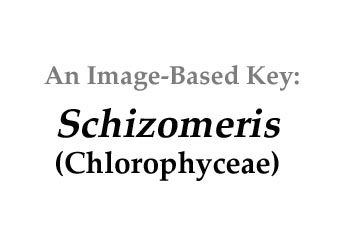|
|
||||
|
Click on images for larger format |
||||
Name derivation: |
||||
Classification:
|
||||
Schizomeris leibleinii Kützing 1843; the single species description (S.
leibleinii) is currently accepted taxonomically (Guiry and Guiry 2013).
Order Chaetophorales; Family Schizomeridaceae |
||||
Morphology: |
||||
|
Unbranched green trichome, uniseriate at base and di- or triseriate in more distal regions. Basal cells in uniseriate region are cylindrical, while more distal cells in multiseriate region are quadrate. Asexual reproduction with quadriflagellate zoospores (planospores). |
||||
Similar genera: |
||||
|
|
||||
Missing Link in
Genetic Ancestry:
|
||||
|
Within
the class Chlorophyceae, one of five major lineages is the Chaetophorales,
the group to which Schizomeris
leibleinii belongs. As it is a
member of one of the earliest diverging lineages, examining the chloroplast
genome of that species and Stigeoclonium
helveticum reveals bidirectional cpDNA replication. This shared structural characteristic was probably
inherited from the common ancestor of all chaetophoralean algae. This
chaetophoralean genome displays less variation in intron sequence and is more
conserved in gene order than the chlamydomonadalean line, linking the two
previously mentioned algae to a single common ancestor (Brouard et al. 2011). |
||||
Antifungal and
Antibacterial Activity:
|
||||
|
In
a recent study conducted in India, it was found that Schizomeris leibleinii, apparently the most widely studied
species from the genus, has antifungal and antibacterial properties. A cold water extract of S. leibleinii exhibited total
inhibitory growth against plant pathogenic fungi (Kamble et al. 2012). In a similar study with warm water
extracts, S. leibleinii inhibited
the growth of Bacillus megaterium,
a gram-positive bacterium (Kamble and Chavan 2010). These inhibitory properties could prove
useful in agricultural settings for the biological remediation and prevention
of bacterial and fungal growth, without the use of synthesized
chemicals. |
||||
Bioabsorption of
heavy metals:
|
||||
|
Inactive
cultures of Schizomeris leibleinii are
useful in removing iron(III) ions and lead(II) ions from industrial waste
waters. High absorption rates and
capacities of the biological waste, inactive S. leibleinii, were effective at concentration of metal ions up
to 150 mg L-1. Multistage
reactors are necessary in this process as they can be designed to estimate
the amount of biological waste necessary to absorb a definite amount of metal
ions (Özera et al. 1999). |
||||
Habitat: |
||||
|
Subaerial in warm temperate to tropical habitats. Recorded from several locations in Scotland (John 2011). Epilithic. |
||||
References: |
||||
|
Brouard,
J.S., O. Christian, C. Lemieux and M. Turmel 2011. The Chloroplast Genome of
the Green Alga Schizomeris leibleinii
(Chlorophyceae) Provides Evidence for Bidirectional DNA Replication from a
Single Origin in the Chaetophorales. Genome Biology and Evolution 3L 505-515. Guiry, M.D. and G.M. Guiry 2013.
AlgaeBase. World-wide electronic publication, National
University of Ireland, Galway.
http://www.algaebase.org; searched on 17 May 2013. John, D.M.
2011. Orders Chaetophorales,
Microsporales, Ulotrichales. In: John, D.M., B.A. Whitton and A.J. Brook
(Eds.) The freshwater algal flora of
the British Isles (p. 546). Kamble, S.M,
A.U. Rokde and A.M. Chavan 2012. Antifungal activity of algal extracts
against plant pathogenic fungi. International Multidisciplinary Research
Journal 2:23-24. Kamble,
S.M., and A.M Chavan 2010. Regular Article Antibacterial Activity of some
Fresh Water Algae. Journal of Experimental Sciences 1: 05-06. Kützing, F.T.
1843. Phycologia generalis oder
Anatomie, Physiologie und Systemkunde der Tange... Mit 80 farbig gedruckten
Tafeln, gezeichnet und gravirt vom Verfasser. pp. [part 1]: [i]-xxxii,
[1]-142, [part 2:] 143-458, 1, err.], pls 1-80. Leipzig: F.A. Brockhaus. Özera, A., D.
Özera and H. I. Ekizb 1999. Application of Freundlich and Langmuir models to
multistage purification process to remove heavy metal ions by using Schizomeris leibleinii. Process
Biochemistry 34: 919–927. |
||||

